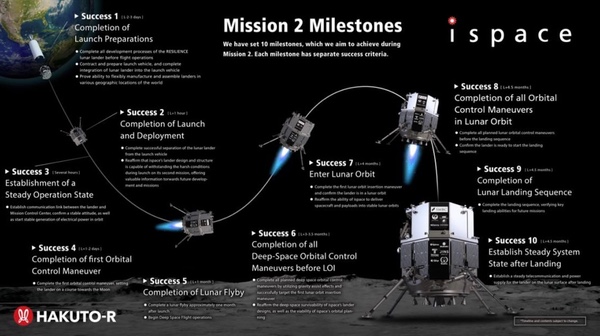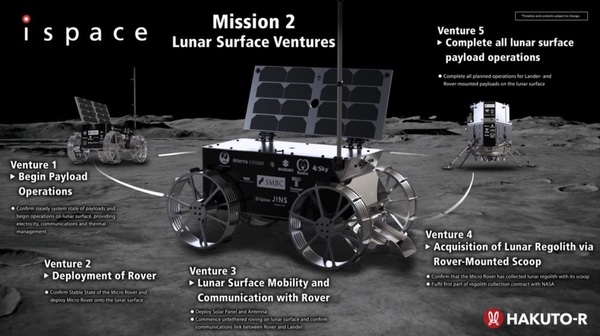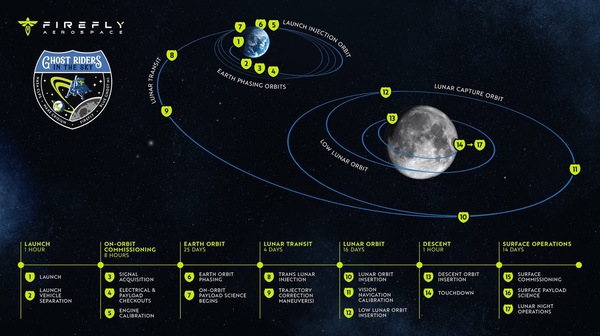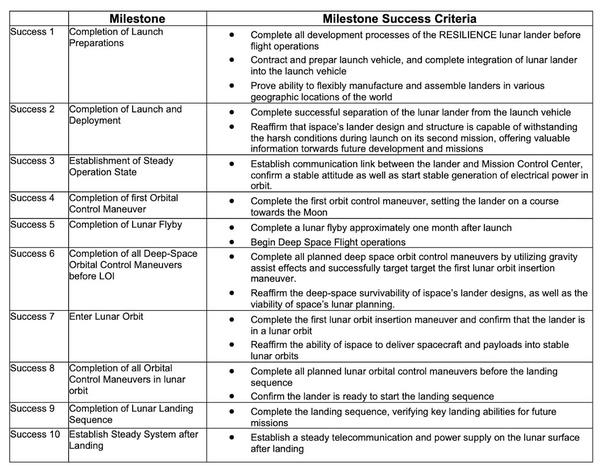What makes a lunar landing mission “successful”?by Jatan Mehta
|
 |
 |
 |
Note that ispace even went ahead and included a table which lists specific actions or criteria to be met for each of those milestones:
 |
This exercise is something publicly traded ispace also did during its first Moon mission. It respectfully stuck to its success criteria despite the outcome of a failed landing.
| Breaking a lander leg does not constitute a soft landing no matter which dictionary you use. |
But this wasn’t the case when the Odysseus spacecraft from US-based Intuitive Machines attempted its first Moon landing as part of NASA’s Commercial Lunar Payload Services (CLPS) program last year, when the publicly traded company as well as NASA retrospectively skewed the success criteria for the mission and straight up falsely proclaimed it as a “soft and safe landing” and an “unqualified success.”
Breaking a lander leg does not constitute a soft landing no matter which dictionary you use, an utterly simple fact that most media outlets supposed to keep tax dollars accountable seem to have forgotten. Most of Odysseus’ payloads collected limited data and one collected none due to the anomalous landing, which clearly means the majority of the scientific objectives weren’t met either.
In fact, by all technical measures, the hard landing of JAXA’s SLIM lunar lander was more successful than Odysseus across the board, from the touchdown and the achieved landing precision to payload operations and deployments. SLIM has sparked an era of precision landings crucial for future crewed exploration, which includes implications for Artemis through a JAXA-NASA partnership. Despite that, JAXA honored the explicit success criteria for SLIM it had defined pre-launch. Moreover, despite the SLIM lander also having tipped over post its lunar touchdown like Odysseus did, and that it couldn’t even generate power until the Sun circled to the other side over a week later in the future, JAXA nevertheless provided a press update within two hours of the landing which sincerely accepted SLIM’s mixed bag of outcomes.
And yet the Western media at large has perpetuated Intuitive Machines’ first Moon landing attempt as being more successful than it really was while not crediting SLIM’s achievements even half as much.
The hard landing of Intuitive Machines’ Odysseus craft has also been incessantly touted as having created “commercial” success but that too is questionable. As a key example, Jeff Foust noted the following numbers in a November 2024 piece on the search for a commercial lunar economy:
In its 10-Q filing this month, Intuitive Machines noted that its IM-1 lander mission in February, along with its upcoming IM-2 and IM-3 missions—all part of CLPS—are considered “loss contracts” by the company as the cost of executing those missions exceeds the revenue expected from NASA and commercial customers, with $22.8 million in combined losses recorded on them this year alone. Even when working for the government, it can be hard to make money on the Moon.
I wish I could say the issues above are limited to Odysseus. In NASA’s plans to procure lunar navigation and communications as a service for its crewed Artemis program, of which Intuitive Machines is a key provider, the agency has been opaque in publicly communicating its contract values and related specifics. This has also notably been the case for NASA transferring operations of two of its key lunar orbital imagers to Intuitive Machines.
These traits should be concerning for the US space communities, who often are the first ones to call out other countries for lack of transparency.
| If we truly want sustainable lunar exploration, we also need to be true to ourselves. Do we desire our Moonbase to be built on a house of cards or on concrete? |
Don’t get me wrong. Even in my piece critiquing the Odysseus mission’s public communications, I’ve admired the technical feats Intuitive objectively achieved, including Odysseus being the first to lunar land using cryogenic methalox engines and remarkably making it to the Moon alive using only optical navigation and an IMU. I’ve also been covering Intuitive’s upcoming second and third Moon landing missions contracted by NASA under CLPS, the latter’s science, their recently contracted fourth CLPS mission, and several other related developments for years. I even helped make a video on their upcoming missions!
But that does not mean I will celebrate Intuitive’s first Moon landing as being more successful than it really was—even if it has been normalized now. Just like how ISRO retrospectively calling the Chandrayaan 2 mission a “98% success” despite the crashed lander does not make it so, Intuitive and NASA redefining the mission doesn’t change the past.
Another reason to raise the issue is that I have grown up being immensely inspired by NASA. I hold great admiration for many pioneering aspects of the agency. I’m often found urging ISRO officials to follow NASA’s long-standing example in communicating the science and technology aspects of civil space missions. But I don’t believe this recent facet of NASA vis-à-vis Artemis is healthy in the long run, especially when the US aims to be the country leading sustainable exploration at the Moon.
If we truly want sustainable lunar exploration, we also need to be true to ourselves. Do we desire our Moonbase to be built on a house of cards or on concrete?
And so I hope that with ispace’s and Firefly’s upcoming Moon landing attempts, the organizations will follow the honorable example of ispace’s own past communications in the event of a landing failure, or leave a trail of transparency like Astrobotic did when its ailing lander precluded a lunar descent attempt altogether. Likewise, in the case of success, I hope they choose the outlook of SLIM’s humble embrace. To me, this is what makes a Moon mission successful other than the obviously needed technical execution. We carry both these choices into the future.
Note: we are now moderating comments. There will be a delay in posting comments and no guarantee that all submitted comments will be posted.
